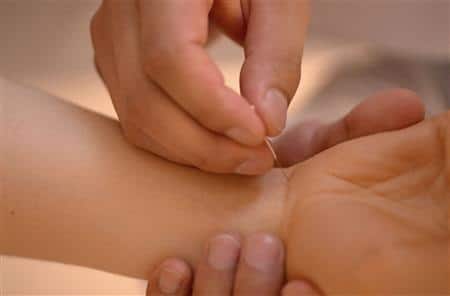Repetitive strain injuries (RSI), also known as cumulative trauma disorders (CTD), are extremely common and are one of the most frequent musculoskeletal issues to present in an acupuncture clinic.

As the name suggests they are injuries of overuse. They result from repeating the same movements, again and again, over prolonged periods of time.
A very common example is an RSI to the wrist from using a computer mouse all day. RSIs are also regularly seen in those who do a lot of typing, or instrument playing, or golf, or in the hand of a hairdresser using a pair of scissors all day.
Continuous overuse of one area of the body, or continuously holding an awkward position, can cause inflammation of local tendons and their delicate sheaths, as well as cause microscopic tears in those tendons.
Treating Symptoms of Repetitive Strain Injury
Repetitive strain injuries most commonly occur in the upper extremities – fingers, wrists, forearms, elbows, shoulders. Common symptoms associated with an RSI are:
- Area easily fatigues
- Loss of strength
- Lack of endurance
- Burning sensation
- Swelling
- Tingling or numbness
How does Chinese medicine explain pain?
The basic Chinese medical understanding of pain is as follows. Pain occurs when there is stagnation or blockage to the normal flow of qi (pronounced “chee”, loosely translated as “energy”, this is the stuff that flows through the acupuncture channels) and/or blood.
There are a number of factors that can cause qi or blood to stagnate. One is a traumatic injury. This could be a physical strike or impact, as in a black eye, a rolled ankle, or a broken bone. The event breaks the local conduits so that it is difficult for qi or blood to flow smoothly through the area.
Another factor, and the most relevant to a repetitive strain injury, is depletion of qi and blood. When there is insufficient qi or blood flowing through its respective vessel it tends to stagnate. We often use the analogy of water in a river. When there is plenty of water, it can easily overcome obstacles, but when the river runs low it tends to pool and stagnate.
In the case of an RSI, the overuse has consumed resources in the local area to the point of depletion then eventually stagnation.
How does acupuncture treat RSI?
Acupuncture treatment essentially uses needling to break up and disperse the stagnant qi or blood. Other points, away from the site of the trauma, can also be selected to help with qi and blood production so an area of the body is less likely to become depleted from over use.
The modern bio-medical understanding of how acupuncture treats such injuries is a bit more complex. In short the main effects of the needling are anti-inflammatory, and improved microcirculation.
The anti-inflammatory response to needling is due in part to having a foreign body below the skin, however, the response is a lot greater at the site of a traditional acupuncture point. Why? Unfortunately the process is still not very well understood.
Improved microcirculation is also an important benefit of acupuncture. The tissues that are damaged in a repetitive strain injury are often ones without a naturally strong blood supply – a tendon, or tendon sheath, or ligament.
When we talk of “blood stagnation” in Chinese medicine, as one of the causes of pain, it can literally (though not necessarily) mean old blood that is stuck in the area. Enhancing microcirculation not only helps to hasten the removal of debris from the site, but it also brings fresh resources to the area for the repair of the damaged tissue.
I find that electro-acupuncture enhances the circulation improving effects of regular needling. Electric acupuncture also has the added benefit of bringing about additional pain relief. By over stimulating local nerves, over time, it causes them to down-regulate, to become less reactive.
Treatment recommendations for RSI
1. Rest the problem area
The absolute first line of treatment should be to stop repeating the movement or position that caused the strain the first place. The more severe injuries come about when people ignore the signals and try to push through the pain.
Often, just performing the action less, is not enough. The best results come when you stop altogether, allowing you to give the area a substantial rest. This may require strapping or a splint to prevent accidental use.
Adequate rest can be a difficult and frustrating thing. And it needs to continue for longer than you feel you need.
2. Keep fit and healthy generally
When you are fit and healthy, not only will you be far less likely to suffer a repetitive strain injury, but you will recover more readily from one. This means eat well, get enough sleep, don’t stress too much, and move regularly.
These very basic diet and lifestyle recommendations, which we all know we should be doing, protect us in so many ways. In this situation, they put more water in the river (good diet and adequate rest) and keep the water moving (exercise).
While you may need to immobilise the affected area, keeping the rest of the body moving, will help the recovery.
3. Acupuncture for RSI
As mentioned higher in the article, acupuncture is particularly helpful in treating the local area, to reduce inflammation, lessen pain, and repair microscopic damage.
4. Chinese herbal medicine for RSI
Chinese herbs are taken internally and have more of a systemic effect. Acupuncture would usually be the treatment of choice, however when qi and blood are especially depleted, usually from diet and lifestyle factors in addition to the over use, herbal medicine may be recommended as well.